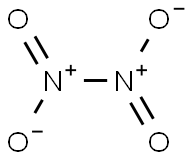Nitrogen Tetroxide

- CAS No.
- 10544-72-6
- Chemical Name:
- Nitrogen Tetroxide
- Synonyms
- N2O4;NITROGEN PEROXIDE;di-nitrogendioxid;NITROGEN TETROXIDE;nitrogentetraoxide;nitrogenoxide(n2o4);Distickstofftetroxid;dinitrogentetraoxide;DINITROGEN TETROXIDE;Dinitrogen tetraoxide
- CBNumber:
- CB5159572
- Molecular Formula:
- N2O4
- Molecular Weight:
- 92.01
- MOL File:
- 10544-72-6.mol
- Modify Date:
- 2024/12/18 14:08:52
| Melting point | −11 °C(lit.) |
|---|---|
| Boiling point | 21 °C(lit.) |
| Density | 2.62 g/mL at 25 °C(lit.) |
| vapor density | 1.58 (21 °C, vs air) |
| vapor pressure | 14.33 psi ( 20 °C) |
| solubility | reacts with H2O |
| form | gas |
| color | colorless liquid; equil with NO |
| Water Solubility | reac H2O [CRC10] |
| Dielectric constant | 2.5(15℃) |
| EPA Substance Registry System | Nitrogen tetroxide (10544-72-6) |
SAFETY
Risk and Safety Statements
| Symbol(GHS) |     GHS03,GHS05,GHS04,GHS06 |
|||||||||
|---|---|---|---|---|---|---|---|---|---|---|
| Signal word | Danger | |||||||||
| Hazard statements | H270-H314-H330 | |||||||||
| Precautionary statements | P260-P264-P280-P301+P330+P331-P303+P361+P353-P363-P304+P340-P310-P321-P305+P351+P338-P405-P501-P220-P244-P370+P376-P403-P260-P271-P284-P304+P340-P310-P320-P403+P233-P405-P501 | |||||||||
| Hazard Codes | T+ | |||||||||
| Risk Statements | 26-34 | |||||||||
| Safety Statements | 9-26-28-36/37/39-45 | |||||||||
| RIDADR | UN 1067 2.3 | |||||||||
| WGK Germany | 1 | |||||||||
| RTECS | QX1575000 | |||||||||
| HS Code | 28112900 | |||||||||
| Hazardous Substances Data | 10544-72-6(Hazardous Substances Data) | |||||||||
| Toxicity | dog,LC50,inhalation,260mg/m3 (260mg/m3),CARDIAC: OTHER CHANGESLUNGS, THORAX, OR RESPIRATION: ACUTE PULMONARY EDEMABEHAVIORAL: CONVULSIONS OR EFFECT ON SEIZURE THRESHOLD,"Spravochnik po Toksikologii i Gigienicheskim Normativam Vol. -, Pg. 6, 1999. | |||||||||
| NFPA 704 |
|
Nitrogen Tetroxide Chemical Properties,Uses,Production
Description
Nitrogen tetraoxide is primarily known for its use as a rocket propellant and became an oxidizer of choice by the late 1950s. Nitrogen tetraoxide has been used as a propellant for missiles as well as for spacecraft beginning with its use in Titan rockets in the late 1950s.
Chemical Properties
col liquid [CRC10]
Physical properties
Colorless liquid or gas; exists in equilibrium with NO2; density 1.45 g/mL at 20°C; boils at 21.25°C; freezes at -9.35°C to a colorless diamagnetic solid; critical temperature 157.85°C; critical pressure 99.64 atm; critical volume 167 cm3/mol; reacts with water.
Uses
Nitrogen tetroxide is a solvent and a powerful and selective oxidizing agent. It’s adducts with organic solvents are used to synthesize nitrates of noble metals.
Preparation
Nitrogen tetroxide always is formed along with nitrogen dioxide during preparation of the dioxide (See Nitrogen Dioxide.) Mixed oxides are produced by oxidation of nitric oxide (NO) in air, heating metal nitrates, or by metals reacting with nitric acids or nitrates.
Definition
A colorless gas that becomes a pale yellow
liquid below 21°C and solidifies below
–11°C. On heating, the gas dissociates to
nitrogen dioxide molecules:
N2O4(g) = 2NO2(g)
This dissociation is complete at 140°C.
Liquid dinitrogen tetroxide has good solvent
properties and is used as a nitrating
agent.
General Description
Red-brown liquid with a sharp, unpleasant chemical odor. Low-boiling (boiling point 21.15°C) and held as a liquid by compression. Density 1.448 g / cm3. Consists of an equilibrium mixture of brown NO2 (nitrogen dioxide) and colorless N2O4 (diNITROGEN DIOXIDE). Evolves poisonous brown vapors. Cylinders and ton containers may not be equipped with a safety relief device. Prolonged exposure of the containers to fire or heat may result in their violent rupturing and rocketing.
Air & Water Reactions
Reacts with water to form nitric acid and nitric oxide.
Hazard
See Nitrogen Dioxide, Hazard.
Health Hazard
Very concentrated fumes produce coughing, choking, headache, nausea, pain in chest and abdomen; otherwise, few symtoms appear at time of exposure. After symptom-free period of 5-72 hours, pulmonary edema gradually develops, causing fatigue, restlessness, coughing, difficulty in breathing, frothy expectoration, mental confusion, lethargy, bluish skin, and weak, rapid pulse. Since NOX interferes with gas exchange in lungs, unconscious- ness and death by asphyxiation can result, usually within a few hours after onset of pulmonary edema.
Safety Profile
A poison. Moderately toxic by inhalation. When heated to decomposition it emits toxic fumes of NOx. See also NITROGEN MONOXIDE.
Environmental Fate
Nitrogen tetroxide is released into the atmosphere where it can undergo reactions, leading to air pollution.
Purification Methods
Purify it by oxidation at 0o in a stream of oxygen until the blue colour changes to red-brown. Alternatively distil it from P2O5, then solidify it by cooling in a deep-freeze (at –78o, giving nearly colourless crystals). Oxygen can be removed by alternate freezing and melting. TOXIC VAPOUR. [Schenk in Handbook of Preparative Inorganic Chemistry (Ed. Brauer) Academic Press Vol I pp 488-489 1963.]
Nitrogen Tetroxide Preparation Products And Raw materials
Raw materials
Preparation Products
1of3
chevron_right




